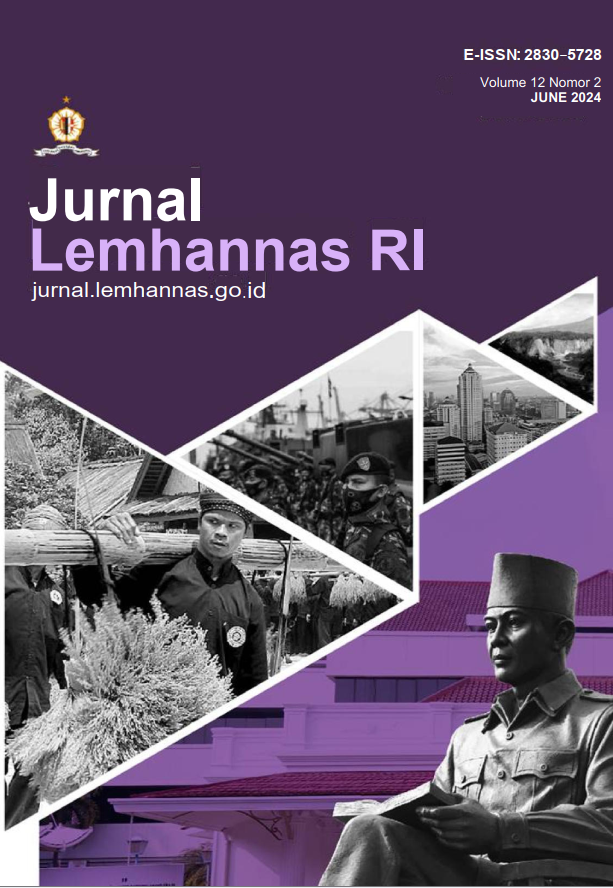The Role of International Cooperation in Indonesia’s Maritime Security: Study Case of MT Arman 114
Main Article Content
Abstract
Purpose: This study explores the critical role of Indonesia's maritime domain in national development, focusing on its function as a connector for its archipelagic geography and a repository of natural resources. It highlights biological resources, such as fisheries, and non-biological resources, including natural gas and oil reserves, while emphasising the importance of safeguarding and optimising these assets for sustainable growth.
Study Design/Methodology/Approach: The research utilises a qualitative approach, using secondary data from government reports, academic studies, and international maritime frameworks. A thematic analysis examines challenges and opportunities in Indonesia’s maritime security framework, with particular attention to non-state threats and the role of international cooperation.
Findings: Indonesia’s vast maritime territory, covering 6.4 million square kilometres, offers significant economic and environmental benefits. However, these benefits face threats from illegal, unreported, and unregulated (IUU) fishing, transnational crimes, and environmental degradation. Limited maritime security resources further hinder effective threat mitigation.
Originality/Value: This study highlights the need for a multilateral approach to maritime security challenges. Drawing on the case of the Iranian supertanker MT Arman 114, it underscores the importance of international cooperation and technological advancements in strengthening Indonesia’s maritime security. The research contributes to the broader discourse on maritime security and regional stability in Southeast Asia
Article Details

This work is licensed under a Creative Commons Attribution-ShareAlike 4.0 International License.
References
Agastia, I. G. (2021). Maritime Security Cooperation within the ASEAN Institutional Framework: A gradual shift towards practical cooperation. JAS (Journal of ASEAN Studies), 9(1), 25–48. https://doi.org/10.21512/jas.v9i1.6919
Al Syahrin, M. N. (2018). Kebijakan Poros Maritim Jokowi Dan Sinergitas Strategi Ekonomi Dan Keamanan laut Indonesia. Indonesian Perspective, 3(1), 1–17. https://doi.org/10.14710/ip.v3i1.20175
Arto, R. S., Prakoso, L. Y., & Sianturi, D. (2020). Strategi Pertahanan Laut Indonesia Dalam Perspektif Maritim Menghadapi Globalisasi. Jurnal Strategi Pertahanan Laut, 6(3), 209–229.
Azis, N. A., R., L. T. S., & Hardiwinoto, S. (2016). Kewenangan Badan Keamanan Laut(BAKAMLA) Dalam Pelaksanaan Pengamanan Di Wilayah Perairan Indonesia. Diponegoro Law Journal, 5(4), 1–13. https://doi.org/https://doi.org/10.14710/dlj.2016.15743
Bryman, A. (2016). Social Research Methods. Oxford University Press.
Fathun, L. M. (2019). ASEAN Contemporary Security: Maritime diplomacy in handling of maritime security threats in Malaka Strait. Insignia: Journal of International Relations, 6(1), 50–63. https://doi.org/10.20884/1.ins.2019.6.1.1414
Kembara, G. (2021). Indonesia’s conceptualizations of maritime security. Asia Maritime Transparency Initiative. https://amti.csis.org/indonesias-conceptualizations-of-maritime-security/
Manullang, A. J. (2023). Mendorong Upaya Peningkatan Keamanan Maritim ASEAN: Kepemimpinan Indonesia dalam ASEAN Coast Guard Forum. Jurnal Hubungan Luar Negeri, 8(2), 18–33.
Manulang, M. O., & Setiyono, J. (2023). Maritime security from the perspective of international regulation and enforcement in Indonesia. International Journal of Social Science and Human Research, 6(10). https://doi.org/10.47191/ijsshr/v6-i10-18
Mawangi, G. T. (2023). Bakamla Ungkap Kronologi penangkapan supertanker iran di zee ri. Antara News. https://www.antaranews.com/berita/3629217/bakamla-ungkap-kronologi-penangkapan-supertanker-iran-di-zee-ri
Menzel, A. (2020). Connecting the Dots: Implications of the Intertwined Global Challenges to Maritime Security. In L. Otto (Ed.), Global Challenges in Maritime Security. Springer.
Nasution, A. M. (2018). Peran Nelayan Dalam Membantu instansi Penegak Hukum laut untuk Mencegah Ancaman Keamanan Maritim. Jurnal Pertahanan & Bela Negara, 8(1), 85–103. https://doi.org/10.33172/jpbh.v8i1.267
Octavian, A. (2019). Indonesian Approach and Perspective on Asia’s Regional Maritime Cooperative Engagements. In Indonesian Navy, Global Maritime Fulcrum and ASEAN. Seskoal press.
Okafor-Yarwood, I. (2020). The cyclical nature of maritime security threats: Illegal, unreported, and unregulated fishing as a threat to human and national security in the Gulf of Guinea. African Security, 13(2), 116–146. https://doi.org/10.1080/19392206.2020.1724432
Pebrianto, F. (2020). Kontribusi Sektor kelautan Dan perikanan ke pdb Baru 3,7 persen. Tempo. https://bisnis.tempo.co/read/1383928/kontribusi-sektor-kelautan-dan-perikanan-ke-pdb-baru-37-persen#
Rahmat , F., & Rusdiyanta , R. (2021). Hambatan Indomalphi dalam Menghadapi Ancaman Kelompok Abu Sayyaf Pada Tahun 2016 - 2020 . Balcony: Budi Luhur Journal of Contemporary Diplomacy, 5(1), 77–84.
Sarjito, A. (2023). Peran Teknologi Dalam Pembangunan Kemaritiman Indonesia. Jurnal Lemhannas RI, 11(4), 219–236. https://doi.org/10.55960/jlri.v11i4.483
Setiawan, D. I., Werijon, W., & Widyanto, D. (2022). Optimalisasi Diplomasi TNI Angkatan Laut Dalam Mendukung Kebijakan Indonesia Sebagai Poros Maritim Dunia. Nusantara: Jurnal Ilmu Pengetahuan Sosial, 9(1), 151–159. https://doi.org/http://dx.doi.org/10.31604/jips.v9i1.2022.151-159
Slamet, S. A., Djaenuri, A., Effendy, K., & Lukman, S. (2020). Efektivitas Badan Keamanan Laut dalam Melaksanakan FUNGSI Penegakkan Hukum di Perairan laut Indonesia. PAPATUNG: Jurnal Ilmu Administrasi Publik, Pemerintahan Dan Politik, 2(3), 178–189. https://doi.org/10.54783/japp.v2i3.29
Subarkah, T. (2023). Skor Indeks Keamanan Laut nasional meningkat. Media Indonesia. https://mediaindonesia.com/politik-dan-hukum/640721/skor-indeks-keamanan-laut-nasional-meningkat
Yuddin, N., Widiarty, W. S., & Tehupeiori, A. (2023). Pertanggung Jawaban Perusahaan Pemilik Kapal Terhadap Kasus pencemaran Lingkungan Sebagai akibat Tumpahaan Minyak Muatan Kapal Laut di Indonesia. Jurnal Syntax Idea, 5(12), 1–19. https://doi.org/10.46799/syntax-idea.v5i12.2650





